Experimental Investigation of the Bond Performance at the Interface between Engineered Geopolymer Composites and Existing Concrete
Abstract
:1. Introduction
2. Experimental Program
2.1. Raw Materials and Mix Proportion
2.2. Specimens and Preparation
2.2.1. Production of The Existing Concrete
2.2.2. Interfacial Roughness Treatment
2.2.3. Pouring of the EGC
3. Experimental Setup and Procedure
3.1. Axial Compressive Test for EGC
3.2. Axial Tensile Test for EGC
3.3. Axial Compressive Test for Existing Concrete
3.4. Direct Shear Test of EGC-Existing Concrete Interface Bond Performance
4. Results and Discussion
4.1. Basic Mechanical Properties and Environmental Benefits of EGC
4.2. Failure Modes of Specimens in Interfacial Bond Direct Shear Test
4.3. Load–Slip Curve of the Specimens
4.4. Analysis of Interfacial Bond Strength Parameters
4.4.1. Interface Roughness
4.4.2. Existing Concrete Strength Grade
4.4.3. EGC Strength Grade
4.5. Modeling of Interfacial Bond Strength between EGC and Existing Concrete
5. Conclusions
- (1)
- Increasing the slag proportion in EGC enhances its microstructure, improving the compressive and tensile properties. Additionally, EGC production results in up to 127% lower carbon emissions compared to ECC.
- (2)
- Adhesive failure was the primary mode observed. The fiber bridging effect at the interface prevented immediate separation of the existing concrete and EGC, reducing brittleness. Higher interface roughness altered the failure path and increased the bond surface area, enhancing mechanical interlocking.
- (3)
- Within certain limits, interface bond strength increased with greater interface roughness, existing concrete strength, and EGC strength. Interface roughness and EGC strength had significant impacts, while existing concrete strength had a lesser, but still positive, effect.
- (4)
- A direct shear bond mechanical model was developed, correlating existing concrete strength, interface roughness, and EGC strength. Validation showed the model is applicable when the post-cast material is stronger than the existing concrete and when the concrete interface is chiseled. Prediction errors were generally within 30%. This study used fly ash and slag, activated with sodium hydroxide and sodium silicate, to make EGC. Future research should test other precursors and activation systems for EGC and concrete interfaces.
- (5)
- This study focused on interface roughness, existing concrete strength, and EGC strength, without considering interface moisture content or bonding agents. Other factors like curing conditions, interface treatment, and environmental exposure also affect bond performance. Adverse conditions like wet–dry cycles, seawater erosion, and freeze–thaw cycles also deserve to be explored for their potential impact.
Author Contributions
Funding
Data Availability Statement
Conflicts of Interest
References
- Wu, L.; Farzadnia, N.; Shi, C.; Zhang, Z.; Wang, H. Autogenous shrinkage of high performance concrete: A review. Constr. Build. Mater. 2017, 149, 62–75. [Google Scholar] [CrossRef]
- Aggelis, D.G. Classification of cracking mode in concrete by acoustic emission parameters. Mech. Res. Commun. 2011, 38, 153–157. [Google Scholar] [CrossRef]
- Khan, I.; Xu, T.; Castel, A.; Gilbert, R.I. Early-age tensile creep and shrinkage induce cracking in internally restrained concrete members. Mag. Concr. Res. 2018, 71, 1167–1179. [Google Scholar] [CrossRef]
- Tennakoon, C.; Shayan, A.; Sanjayan, J.G.; Xu, A. Chloride ingress and steel corrosion in geopolymer concrete based on long term tests. Mater. Des. 2017, 116, 287–299. [Google Scholar] [CrossRef]
- Grengg, C.; Müller, B.; Staudinger, C.; Mittermayr, F.; Breininger, J.; Ungerböck, B.; Borisov, S.M.; Mayr, T.; Dietzel, M. High-resolution optical pH imaging of concrete exposed to chemically corrosive environments. Cem. Concr. Res. 2019, 116, 231–237. [Google Scholar] [CrossRef]
- Shaheen, F.; Pradhan, B. Influence of sulfate ion and associated cation type on steel reinforcement corrosion in concrete powder aqueous solution in the presence of chloride ions. Cem. Concr. Res. 2017, 91, 73–86. [Google Scholar] [CrossRef]
- Fu, C.; Ye, H.; Jin, X.; Yan, D.; Jin, N.; Peng, Z. Chloride penetration into concrete damaged by uniaxial tensile fatigue loading. Constr. Build. Mater. 2016, 125, 714–723. [Google Scholar] [CrossRef]
- Huang, Y.; Ye, H.; Fu, C.; Jin, N. Modeling moisture transport at the surface layer of fatigue-damaged concrete. Constr. Build. Mater. 2017, 151, 196–207. [Google Scholar] [CrossRef]
- Zhao, Y.; Yu, M.; Xiang, Y.; Kong, F.; Li, L. A sustainability comparison between green concretes and traditional concrete using an emergy ternary diagram. J. Clean Prod. 2020, 256, 120421. [Google Scholar] [CrossRef]
- Ekolu, S.O. Implications of global CO2 emissions on natural carbonation and service lifespan of concrete infrastructures—Reliability analysis. Cem. Concr. Compos. 2020, 114, 103744. [Google Scholar] [CrossRef]
- Su, J.; Luo, R.; Chen, Z.; Lin, J.; Huang, P.; Guo, Y. Experimental study on the fracture performance of rubberized high strength-high ductility concrete with j-integral method. Constr. Build. Mater. 2024, 421, 135668. [Google Scholar] [CrossRef]
- Liu, H.; Zhang, Q.; Gu, C.; Su, H.; Li, V.C. Influence of micro-cracking on the permeability of engineered cementitious composites. Cem. Concr. Compos. 2016, 72, 104–113. [Google Scholar] [CrossRef]
- Lu, C.; Leung, C.K.; Li, V.C. Numerical model on the stress field and multiple cracking behavior of engineered cementitious composites (ECC). Constr. Build. Mater. 2017, 133, 118–127. [Google Scholar] [CrossRef]
- Lin, J.; Song, Y.; Xie, Z.; Guo, Y.; Yuan, B.; Zeng, J.; Wei, X. Static and dynamic mechanical behavior of engineered cementitious composites with PP and PVA fibers. J. Build. Eng. 2020, 29, 101097. [Google Scholar] [CrossRef]
- Ahmed, S.F.U.; Maalej, M. Tensile strain hardening behaviour of hybrid steel-polyethylene fibre reinforced cementitious composites. Constr. Build. Mater. 2009, 23, 96–106. [Google Scholar] [CrossRef]
- Lu, C.; Leung, C.K.Y. Theoretical evaluation of fiber orientation and its effects on mechanical properties in engineered cementitious composites (ECC) with various thicknesses. Cem. Concr. Res. 2017, 95, 240–246. [Google Scholar] [CrossRef]
- Teng, X.; Lu, C.; Li, C.; Chen, Z. Investigation on shear mechanical behavior of the interface between sulphoaluminate cement (SAC)-ECC and existing concrete. Constr. Build. Mater. 2023, 403, 133184. [Google Scholar] [CrossRef]
- Hou, M.; Hu, K.; Yu, J.; Dong, S.; Xu, S. Experimental study on ultra-high ductility cementitious composites applied to link slabs for jointless bridge decks. Compos. Struct. 2018, 204, 167–177. [Google Scholar] [CrossRef]
- Zheng, Y.; Zhang, L.F.; Xia, L.P. Investigation of the behaviour of flexible and ductile ECC link slab reinforced with FRP. Constr. Build. Mater. 2018, 166, 694–711. [Google Scholar] [CrossRef]
- Li, V.C. Tailoring ECC for special attributes: A review. Int. J. Concr. Struct. Mater. 2012, 6, 135–144. [Google Scholar] [CrossRef]
- Wang, S.; Li, V. Engineered cementitious composites with high-volume fly ash. ACI Mater. J. 2007, 104, 233–241. [Google Scholar] [CrossRef]
- Manjunatha, M.; Seth, D.; Kvgd, B.; Roy, S.; Tangadagi, R.B. Utilization of industrial-based pvc waste powder in self-compacting concrete: A sustainable building material. J. Clean Prod. 2023, 428, 139428. [Google Scholar] [CrossRef]
- Guo, X.; Liu, X.; Yuan, S. Effects of initial damage on self-healing of fly ash-based engineered geopolymer composites (FA-EGC). J. Build. Eng. 2023, 74, 106901. [Google Scholar] [CrossRef]
- Wang, F.; Ma, J.; Ding, Y.; Yu, J.; Yu, K. Engineered geopolymer composite (EGC) with ultra-low fiber content of 0.2%. Constr. Build. Mater. 2024, 411, 134626. [Google Scholar] [CrossRef]
- Lin, J.; Liu, R.; Liu, L.; Zhuo, K.; Chen, Z.; Guo, Y. High-strength and high-toughness alkali-activated composite materials: Optimizing mechanical properties through synergistic utilization of steel slag, ground granulated blast furnace slag, and fly ash. Constr. Build. Mater. 2024, 422, 135811. [Google Scholar] [CrossRef]
- Lao, J.; Huang, B.; Xu, L.; Khan, M.; Fang, Y.; Dai, J. Seawater sea-sand engineered geopolymer composites (EGC) with high strength and high ductility. Cem. Concr. Compos. 2023, 138, 104998. [Google Scholar] [CrossRef]
- Peng, Y.; Zheng, D.; Pan, H.; Yang, J.; Lin, J.; Lai, H.; Wu, P.-Z.; Zhu, H.-Y. Strain hardening geopolymer composites with hybrid pom and UHMWPE fibers: Analysis of static mechanical properties, economic benefits, and environmental impact. J. Build. Eng. 2023, 76, 107315. [Google Scholar] [CrossRef]
- Zhang, Z.; Yu, J.; Qin, F.; Sun, F. Thermal effect on mechanical properties of metakaolin-based engineered geopolymer composites (EGC). Case Stud. Constr. Mater. 2023, 18, e02150. [Google Scholar] [CrossRef]
- Juenger, M.C.G.; Winnefeld, F.; Provis, J.L.; Ideker, J.H. Advances in alternative cementitious binders. Cem. Concr. Res. 2011, 41, 1232–1243. [Google Scholar] [CrossRef]
- Shi, C.; Jiménez, A.F.; Palomo, A. New cements for the 21st century: The pursuit of an alternative to portland cement. Cem. Concr. Res. 2011, 41, 750–763. [Google Scholar] [CrossRef]
- Bakharev, T. Durability of geopolymer materials in sodium and magnesium sulfate solutions. Cem. Concr. Res. 2005, 35, 1233–1246. [Google Scholar] [CrossRef]
- Rostami, M.; Behfarnia, K. The effect of silica fume on durability of alkali activated slag concrete. Constr. Build. Mater. 2017, 134, 262–268. [Google Scholar] [CrossRef]
- Haruna, S.; Mohammed, B.; Wahab, M.M.A. Effect of GGBS slag on setting time and compressive strength of one-part geopolymer binders. J. Infrastruct. Facil. Asset Manag. 2020, 2, 149–160. [Google Scholar] [CrossRef]
- Lemougna, P.N.; Nzeukou, A.; Aziwo, B.; Tchamba, A.B.; Wang, K.; Melo, U.C.; Cui, X.-M. Effect of slag on the improvement of setting time and compressive strength of low reactive volcanic ash geopolymers synthetized at room temperature. Mater. Chem. Phys. 2020, 239, 122077. [Google Scholar] [CrossRef]
- He, Y.; Zhang, X.; Hooton, R.D.; Zhang, X. Effects of interface roughness and interface adhesion on new-to-old concrete bonding. Constr. Build. Mater. 2017, 151, 582–590. [Google Scholar] [CrossRef]
- Zhong, S.; Hu, X.; Yang, B.; Peng, G. Bond performance between cementitious grout and normal concrete subjected to freeze–thaw damage. Constr. Build. Mater. 2023, 405, 133344. [Google Scholar] [CrossRef]
- Shah, S.; Kishen, J.M. Fracture properties of concrete–concrete interfaces using digital image correlation. Exp. Mech. 2011, 51, 303–313. [Google Scholar] [CrossRef]
- Courard, L.; Piotrowski, T.; Garbacz, A. Near-to-surface properties affecting bond strength in concrete repair. Cem. Concr. Compos. 2014, 46, 73–80. [Google Scholar] [CrossRef]
- Júlio, E.N.B.S.; Branco, F.A.B.; Silva, V.D. Concrete-to-concrete bond strength. Influence of the roughness of the substrate surface. Constr. Build. Mater. 2004, 18, 675–681. [Google Scholar] [CrossRef]
- Júlio, E.N.B.S.; Branco, F.A.B.; Silva, V.D.; Lourenço, J.F. Influence of added concrete compressive strength on adhesion to an existing concrete substrate. Build. Environ. 2006, 41, 1934–1939. [Google Scholar] [CrossRef]
- Zhang, Y.; Zhu, P.; Liao, Z.; Wang, L. Interfacial bond properties between normal strength concrete substrate and ultra-high performance concrete as a repair material. Constr. Build. Mater. 2020, 235, 117431. [Google Scholar] [CrossRef]
- Kumar, S.; Sekhar Das, C.; Lao, J.; Alrefaei, Y.; Dai, J. Effect of sand content on bond performance of engineered geopolymer composites (EGC) repair material. Constr. Build. Mater. 2022, 328, 127080. [Google Scholar] [CrossRef]
- Austin, S.; Robins, P.; Pan, Y. Shear bond testing of concrete repairs. Cem. Concr. Res. 1999, 29, 1067–1076. [Google Scholar] [CrossRef]
- Semendary, A.A.; Svecova, D. Factors affecting bond between precast concrete and cast in place ultra high performance concrete (UHPC). Eng. Struct. 2020, 216, 110746. [Google Scholar] [CrossRef]
- Santos, P.; Júlio, E. Factors affecting bond between new and old concrete. ACI Mater. J. 2011, 108, 449–456. [Google Scholar] [CrossRef]
- Wang, B.; Feng, H.; Huang, H.; Guo, A.; Zheng, Y.; Wang, Y. Bonding properties between fly ash/slag-based engineering geopolymer composites and concrete. Materials 2023, 16, 4232. [Google Scholar] [CrossRef]
- Costa, H.; Carmo, R.N.F.; Júlio, E. Influence of lightweight aggregates concrete on the bond strength of concrete-to-concrete interfaces. Constr. Build. Mater. 2018, 180, 519–530. [Google Scholar] [CrossRef]
- Modesti, L.A.; Vargas, A.S.D.; Schneider, E.L. Repairing concrete with epoxy adhesives. Int. J. Adhes. Adhes. 2020, 101, 102645. [Google Scholar] [CrossRef]
- Jiang, B.; Qian, Z.; Gu, D.; Pan, J. Repair concrete structures with high-early-strength engineered cementitious composites (HES-ECC): Material design and interfacial behavior. J. Build. Eng. 2023, 68, 106060. [Google Scholar] [CrossRef]
- Shang, X.; Xu, F.; Yu, J.; Li, L.; Lu, Z. Study on the interfacial shear performance between engineered cementitious composites and concrete after being subjected to high temperatures. J. Build. Eng. 2021, 44, 103328. [Google Scholar] [CrossRef]
- Farzad, M.; Shafieifar, M.; Azizinamini, A. Experimental and numerical study on bond strength between conventional concrete and ultra high-performance concrete (UHPC). Eng. Struct. 2019, 186, 297–305. [Google Scholar] [CrossRef]
- ASTM C469/C469M-22; Standard Test Method for Static Modulus of Elasticity and Poisson’s Ratio of Concrete in Compression. ASTM International: West Conshohocken, PA, USA, 2022.
- Yokota, H.; Rokugo, K.; Sakata, N. JSCE Recommendations for design and construction of high performance fiber reinforced cement composite with multiple fine cracks. In High Performance Fiber Reinforced Cement Composites; Springer: Tokyo, Japan, 2007. [Google Scholar]
- JGJ 55-2011; Specification for Mix Proportion Design of Ordinary Concrete. MOHURD, Architecture & Building Press: Beijing, China, 2011.
- Santos, P.; Júlio, E. A state-of-art review on roughness quantification methods for concrete surfaces. Constr. Build. Mater. 2013, 38, 912–923. [Google Scholar] [CrossRef]
- Liu, C.; Wei, Y. Experimental study on interface performance between implantable cement-based sensor and matrix concrete. Constr. Build. Mater. 2022, 345, 128316. [Google Scholar] [CrossRef]
- Tian, J.; Wu, X.; Zheng, Y.; Hu, S.; Du, Y.; Wang, W.; Sun, C.; Zhang, L. Investigation of interface shear properties and mechanical model between ECC and concrete. Constr. Build. Mater. 2019, 223, 12–27. [Google Scholar] [CrossRef]
- Chang, J.J. A study on the setting characteristics of sodium silicate-activated slag pastes. Cem. Concr. Res. 2003, 33, 1005–1011. [Google Scholar] [CrossRef]
- Nath, S.K.; Kumar, S. Influence of iron making slags on strength and microstructure of fly ash geopolymer. Constr. Build. Mater. 2013, 38, 924–930. [Google Scholar] [CrossRef]
- Zhou, Y.; Xi, B.; Sui, L.; Zheng, S.; Xing, F.; Li, L. Development of high strain-hardening lightweight engineered cementitious composites: Design and performance. Cem. Concr. Compos. 2019, 104, 103370. [Google Scholar] [CrossRef]
- Long, X.; Xue, H.; Tan, Y.; Xia, C.; Huang, X.; Yan, X.; Zheng, L. Effect of ultra-low temperature freezing-thawing cycles on bending fatigue properties of PE-ECC. Case Stud. Constr. Mater. 2023, 19, e02603. [Google Scholar] [CrossRef]
- Zhang, Z.; Gao, Y.; Qin, F.; Sun, F.; Huang, Y. Mechanical properties of sustainable high strength ECC with substitution of cement by limestone powder. Case Stud. Constr. Mater. 2023, 19, e02434. [Google Scholar] [CrossRef]
- Lin, J.; Luo, R.; Su, J.; Guo, Y.; Chen, W. Coarse synthetic fibers (PP and POM) as a replacement to steel fibers in UHPC: Tensile behavior, environmental and economic assessment. Constr. Build. Mater. 2024, 412, 134654. [Google Scholar] [CrossRef]
- Chen, G.; Zheng, D.; Chen, Y.; Lin, J.; Lao, W.; Guo, Y.; Chen, Z.-B.; Lan, X.-W. Development of high performance geopolymer concrete with waste rubber and recycle steel fiber: A study on compressive behavior, carbon emissions and economical performance. Constr. Build. Mater. 2023, 393, 131988. [Google Scholar] [CrossRef]
- Park, S.; Choi, J.; Nguyễn, H.H.; Lương, Q.; Nguyễn, P.H.; Lee, B.Y. Cementless ultra-ductile composites reinforced by polyethylene-based short selvedge fibers for sustainable and resilient infrastructure. J. Build. Eng. 2023, 68, 106198. [Google Scholar] [CrossRef]
- Daneshvar, D.; Deix, K.; Robisson, A. Effect of casting and curing temperature on the interfacial bond strength of epoxy bonded concretes. Constr. Build. Mater. 2021, 307, 124328. [Google Scholar] [CrossRef]
- Ha, S.K.; Na, S.; Lee, H.K. Bond characteristics of sprayed frp composites bonded to concrete substrate considering various concrete surface conditions. Compos. Struct. 2013, 100, 270–279. [Google Scholar] [CrossRef]
- Yuan, Q.; Jan, L. Study on adhesive shear strength of young on old concrete. J. Build. Struct. 2001, 22, 46–50. (In Chinese) [Google Scholar]
- Wu, Z.; Zhang, J.; Yu, H.; Wu, Q.; Da, B. Computer-aided investigation of the tensile behavior of concrete: Relationship between direct and splitting tensile strength. Structures 2023, 55, 453–467. [Google Scholar] [CrossRef]
- Ju, Y.; Shen, T.; Wang, D. Bonding behavior between reactive powder concrete and normal strength concrete. Constr. Build. Mater. 2020, 242, 118024. [Google Scholar] [CrossRef]


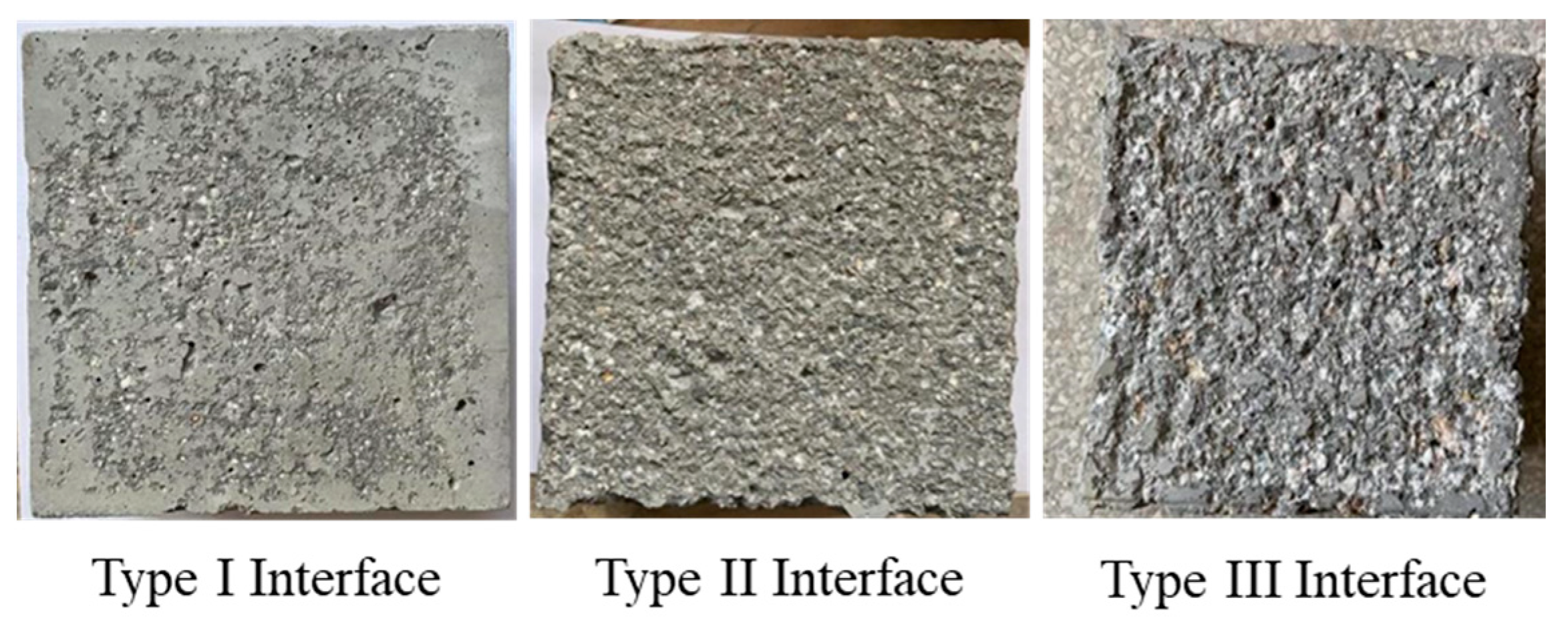
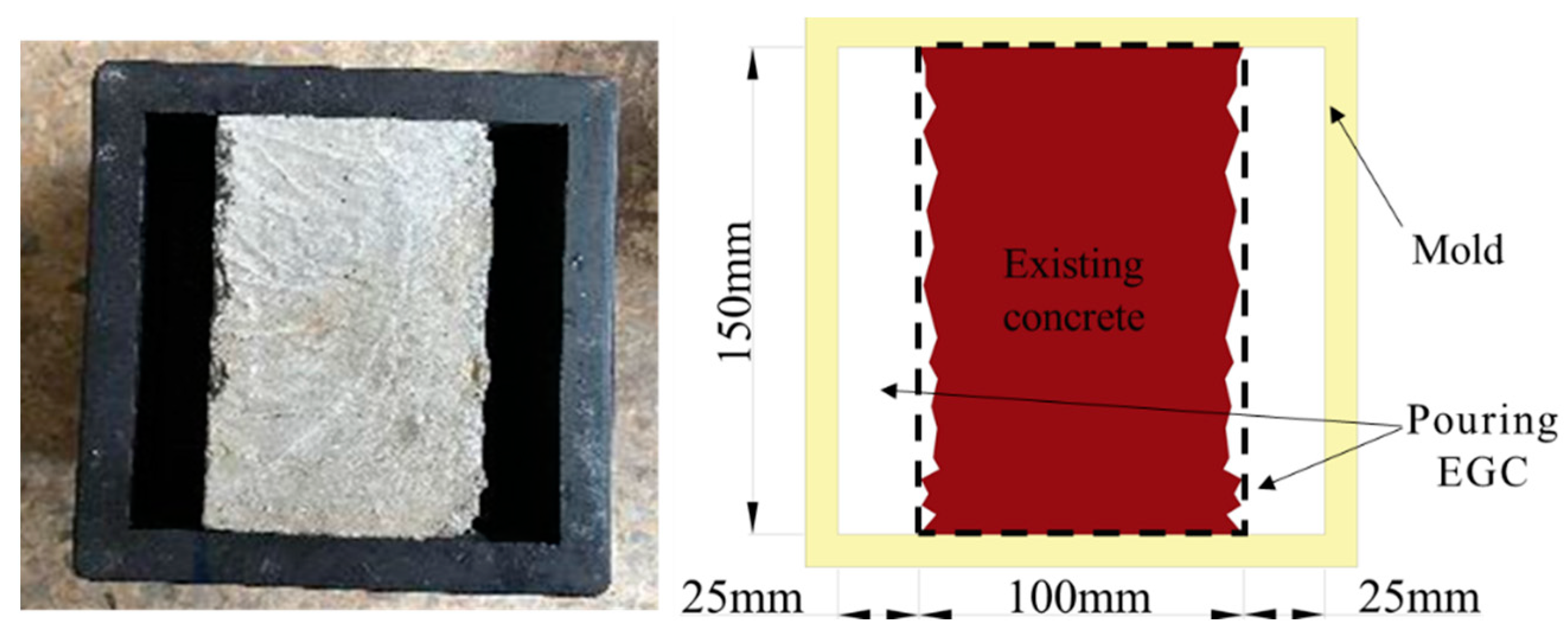

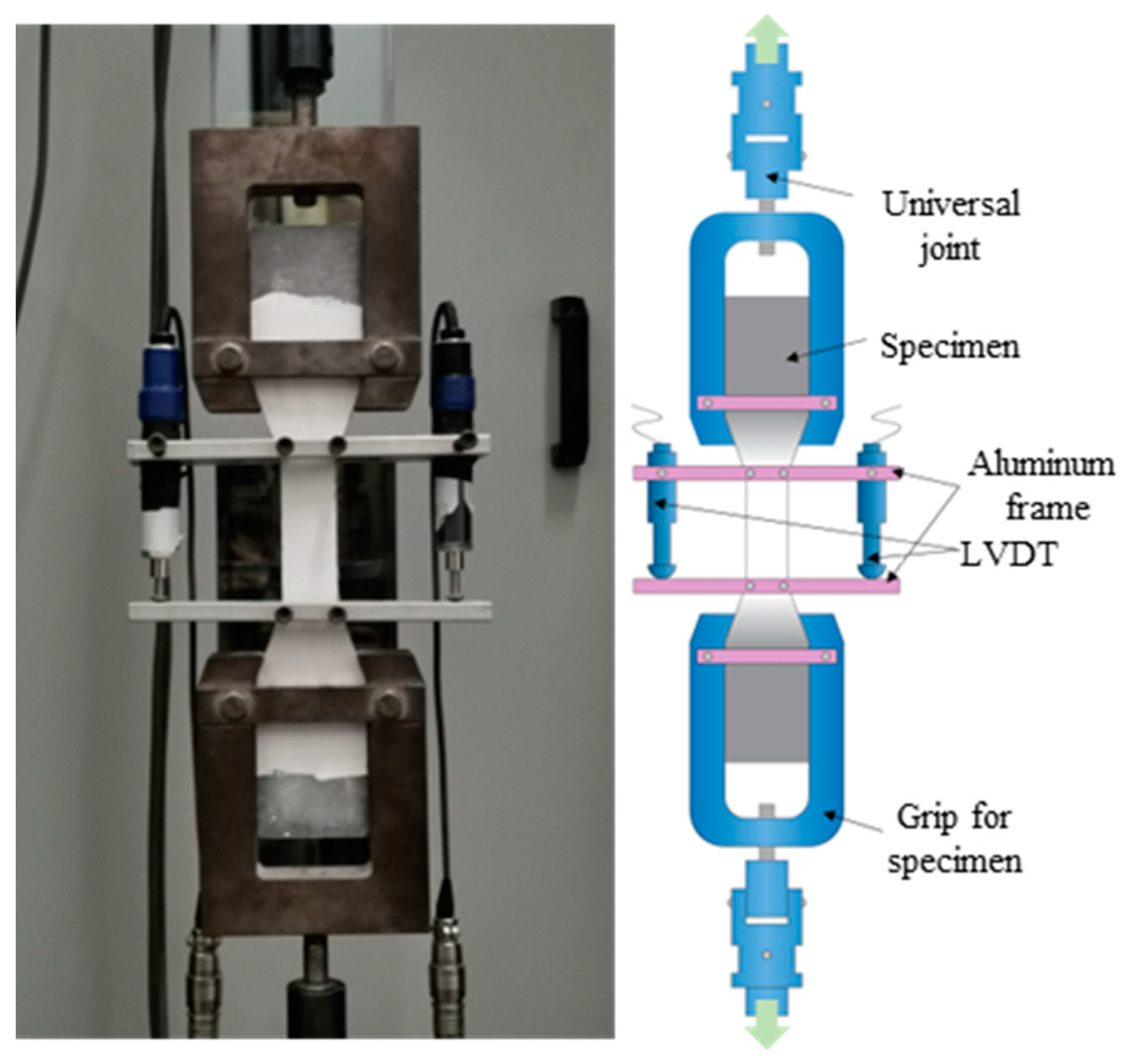
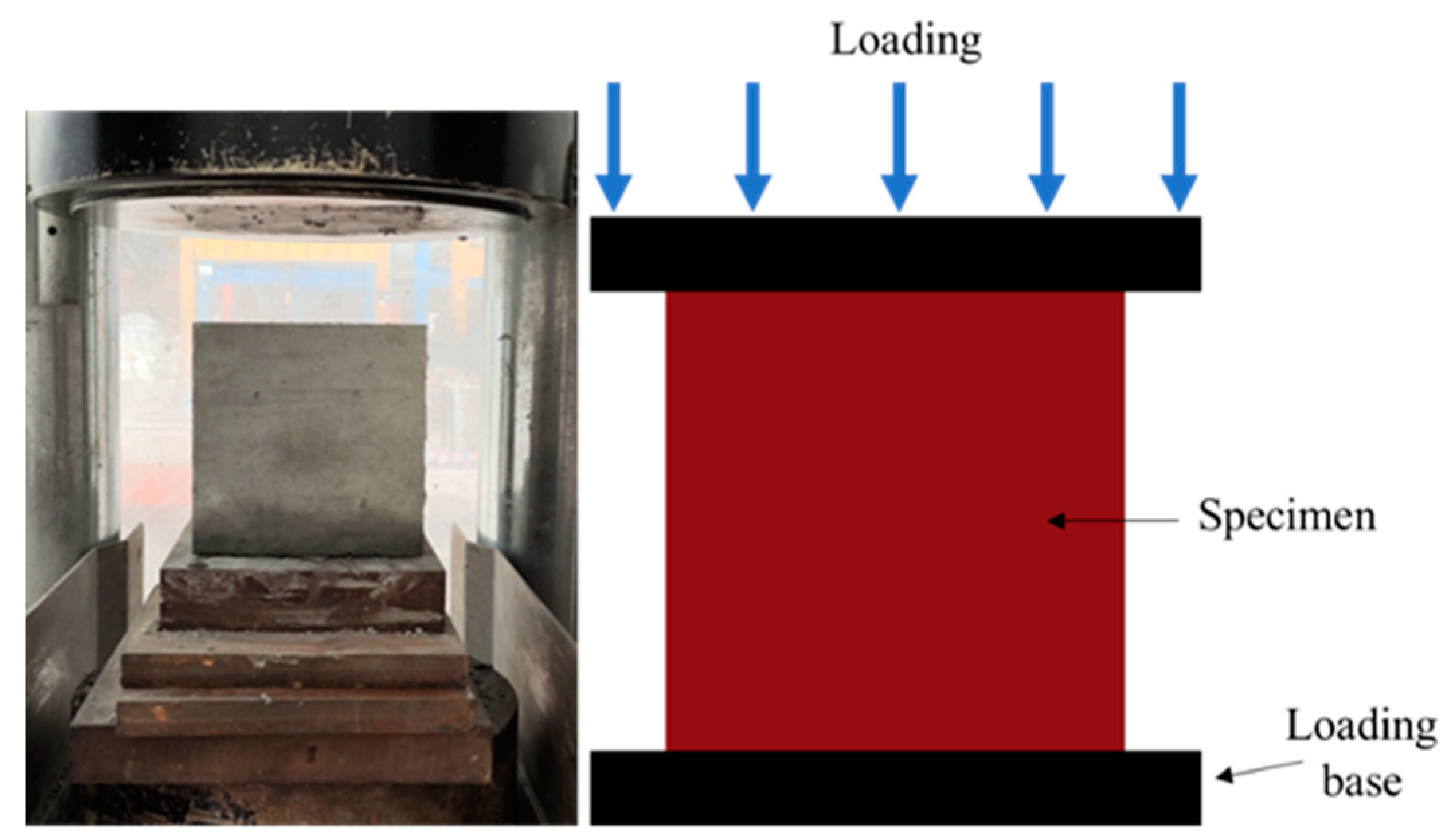



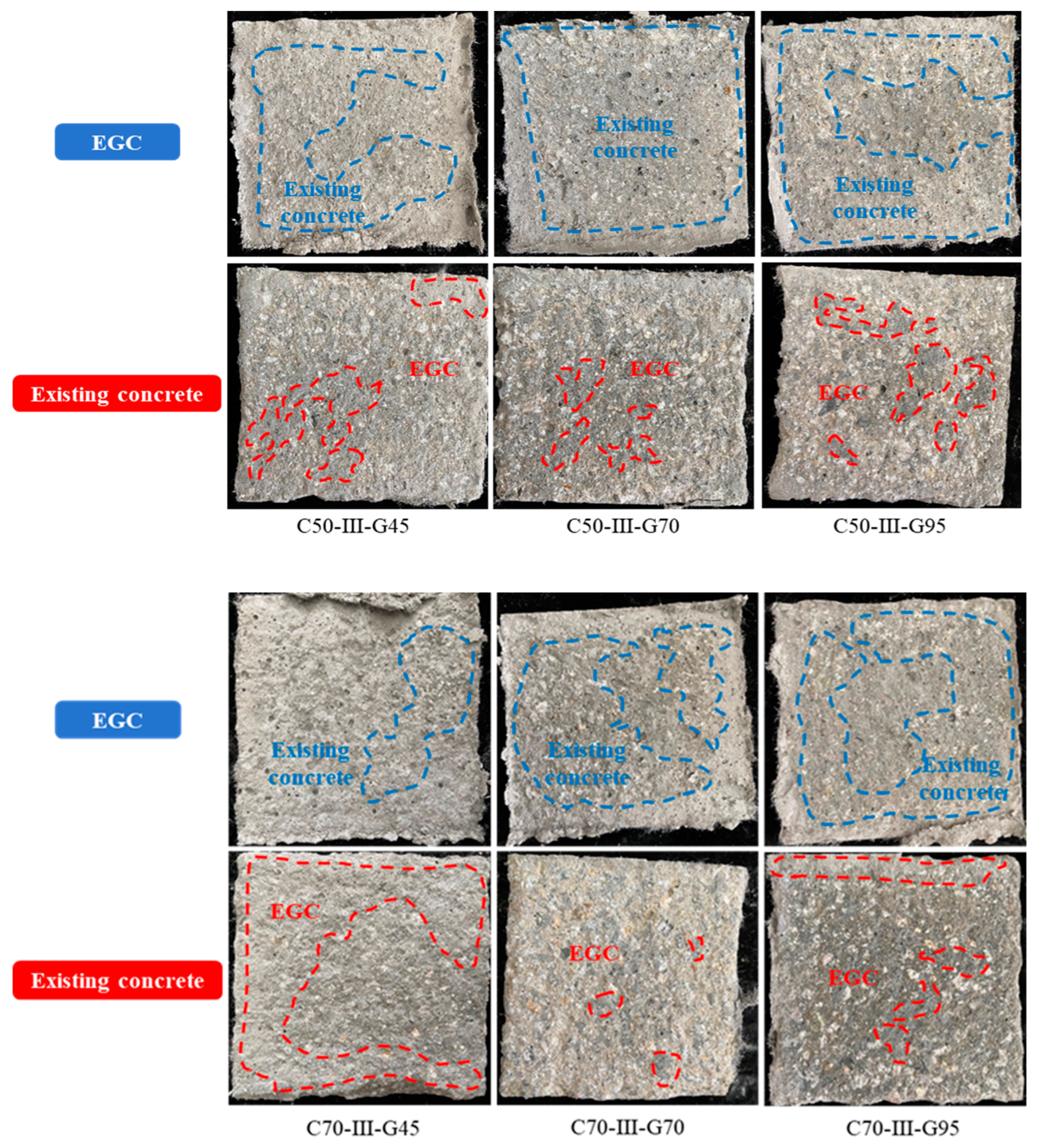
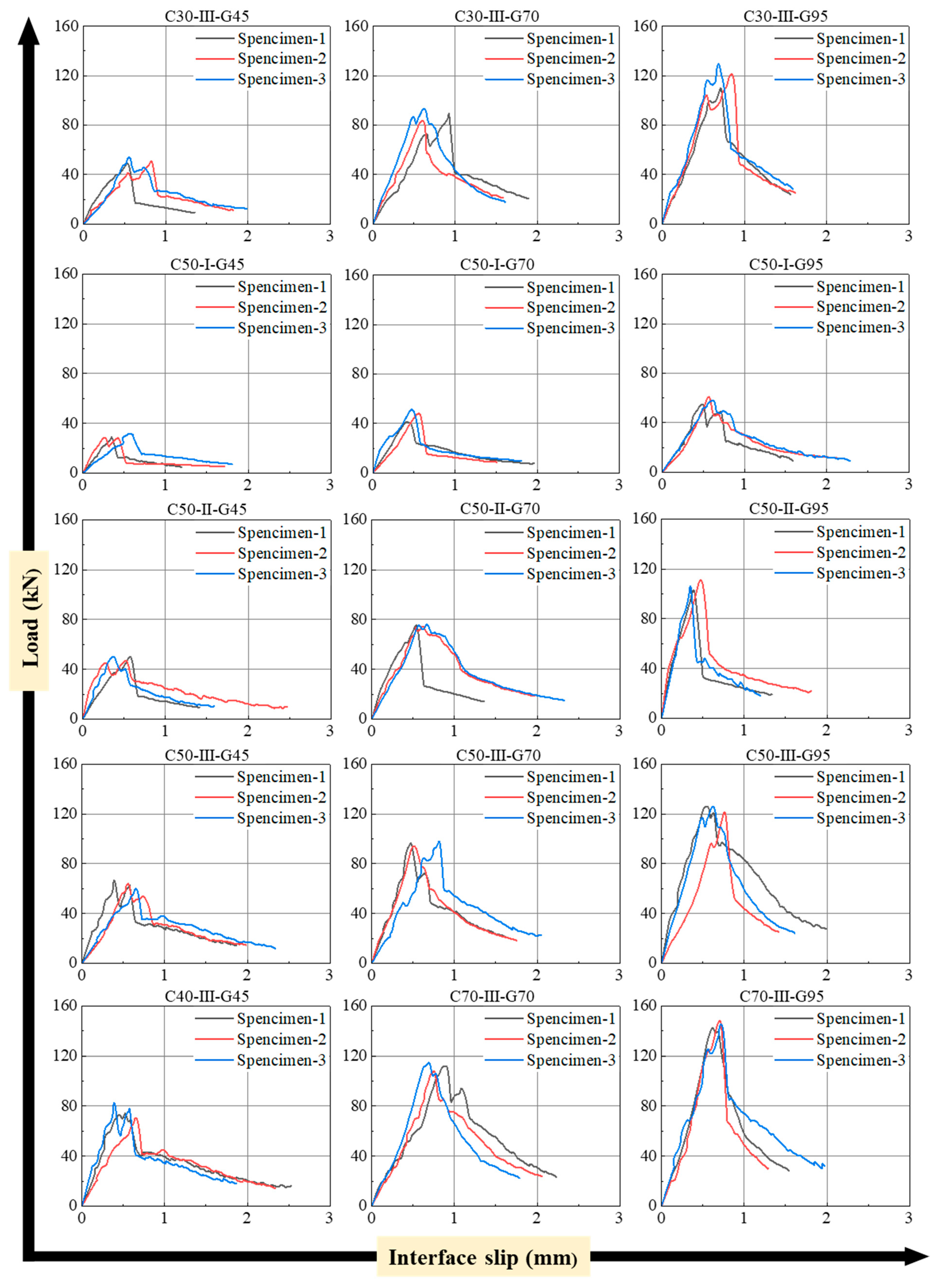


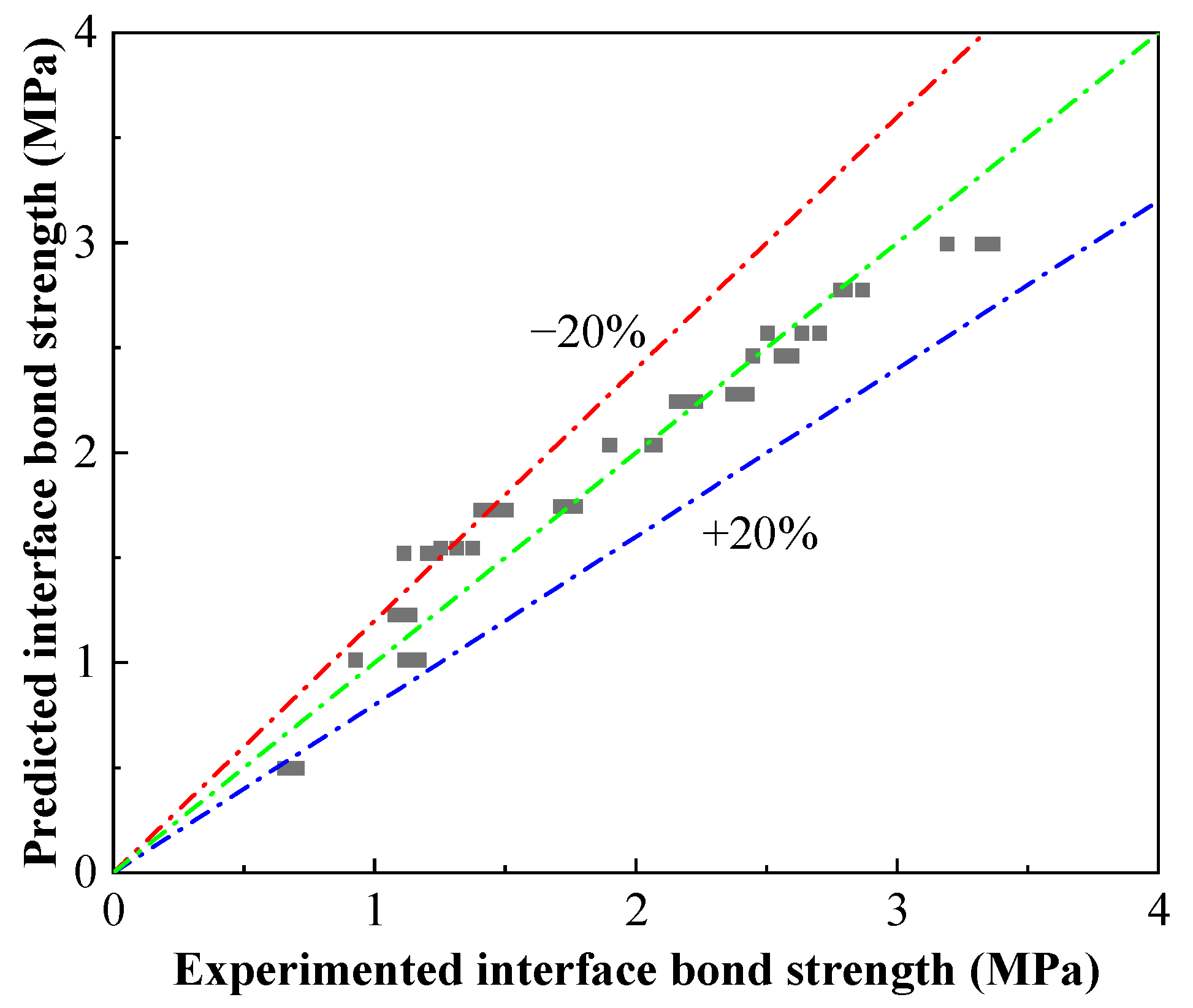

| Binder Materials | CaO | SiO2 | Al2O3 | SO3 | Fe2O3 | MgO | TiO2 | Others | Loss on Ignition |
|---|---|---|---|---|---|---|---|---|---|
| GGBFS | 34.00 | 34.50 | 17.70 | 1.64 | 1.03 | 6.01 | 0 | 5.12 | 0.84 |
| FA | 4.01 | 53.97 | 31.15 | 2.20 | 4.16 | 1.01 | 1.13 | 2.37 | 4.60 |
| Length (mm) | Diameter (mm) | Tensile Strength (MPa) | Elastic Modulus (GPa) | Density (g/cm3) | Elongation (%) |
|---|---|---|---|---|---|
| 18 | 24 | 2500 | 120 | 0.97 | 3.7 |
| Groups | FA | GGBFS | QP | Activator | Water | BaCl2 | PE Fiber |
|---|---|---|---|---|---|---|---|
| G45 | 956.4 | 239.1 | 239.1 | 478.2 | 71.7 | 12.0 | 19.4 |
| G70 | 849.7 | 364.1 | 242.8 | 485.5 | 72.8 | 12.1 | 19.4 |
| G95 | 736.3 | 490.9 | 245.4 | 490.9 | 73.6 | 12.3 | 19.4 |
| Groups | Cement | Coarse Aggregate | Fine Aggregate | Water | SP |
|---|---|---|---|---|---|
| C30 | 316 | 1126 | 750 | 208 | - |
| C50 | 444 | 1112 | 622 | 222 | - |
| C70 | 588 | 1028 | 578 | 164 | 3 |
| Groups | Existing Concrete Strength Grade | Interface Type | EGC Strength Grade |
|---|---|---|---|
| C30-III-G45 | C30 | III | G45 |
| C30-III-G70 | C30 | III | G70 |
| C30-III-G95 | C30 | III | G90 |
| C50-I-G45 | C50 | I | G45 |
| C50-I-G70 | C50 | I | G70 |
| C50-I-G95 | C50 | I | G90 |
| C50-II-G45 | C50 | II | G45 |
| C50-II-G70 | C50 | II | G70 |
| C50-II-G95 | C50 | II | G90 |
| C50-III-G45 | C50 | III | G45 |
| C50-III-G70 | C50 | III | G70 |
| C50-III-G95 | C50 | III | G90 |
| C70-III-G45 | C70 | III | G45 |
| C70-III-G70 | C70 | III | G70 |
| C70-III-G95 | C70 | III | G90 |
| C70-III-G95 | C70 | III | G90 |
| Groups | Compressive Strength (MPa) |
|---|---|
| C30 | 35.6 (1.27) |
| C50 | 54.9 (1.89) |
| C70 | 75.3 (2.53) |
| Groups | Compressive Strength (MPa) | Elasticity Modulus (GPa) | Initial Cracking Strain (%) | Ultimate Tensile Strain (%) | Initial Cracking Stress (MPa) | Tensile Stress (MPa) |
|---|---|---|---|---|---|---|
| G45 | 49.6 (1.15) | 8.88 (0.695) | 0.0340 (0.0200) | 6.10 (0.258) | 1.63 (0.0360) | 5.09 (0.167) |
| G70 | 72.2 (0.364) | 14.1 (0.144) | 0.136 (0.0380) | 7.21 (0.283) | 2.53 (0.167) | 6.32 (0.171) |
| G95 | 96.6 (0.545) | 18.8 (0.883) | 0.198 (0.122) | 7.93 (0.482) | 3.20 (0.0930) | 8.00 (0.336) |
| Materials | Cement | GGBFS | FA | Silica Fume | Quartz Qowder | NaOH | Na2SiO3 | SP | PE Fiber |
|---|---|---|---|---|---|---|---|---|---|
| Emission factor (kg CO2-e/kg) | 0.830 [63] | 0.019 [64] | 0.009 [64] | 0.014 [65] | 0.046 [64] | 1.915 [64] | 1.514 [64] | 0.720 [64] | 1.960 [65] |
| Materials | Mix Groups | |||||
|---|---|---|---|---|---|---|
| G45 | G70 | G95 | Reference (C45) [61] | Reference (C70) [62] | Reference (C95) [60] | |
| Cement | - | - | - | 492.190 | 746.095 | 581.000 |
| GGBFS | 4.543 | 6.918 | 9.327 | - | - | 14.250 |
| FA | 8.608 | 7.647 | 6.627 | 6.404 | 4.061 | - |
| Silica Fume | - | - | - | - | 1.274 | 3.220 |
| Quartz Sand | 10.999 | 11.169 | 11.288 | 21.822 | 20.746 | 23.000 |
| NaOH | 92.491 | 93.903 | 94.947 | - | - | - |
| Na2SiO3 | 211.117 | 214.340 | 216.724 | - | - | - |
| SP | - | - | - | 2.880 | 14.400 | 32.400 |
| PE Fiber | 29.372 | 29.372 | 29.372 | 37.240 | 39.200 | 39.200 |
| CO2-e (kg/m3) | 357.129 | 363.348 | 368.285 | 560.537 | 825.776 | 693.070 |
| Groups | Failure Mode | Interfacial Bond Strength (MPa) | Standard Deviation (MPa) |
|---|---|---|---|
| C30-III-G45 | alternating crack | 1.18 | 0.0515 |
| C30-III-G70 | alternating crack | 2.01 | 0.0793 |
| C30-III-G95 | cohesive failure | 2.61 | 0.0831 |
| C50-I-G45 | serrated interfacial failure | 0.674 | 0.0209 |
| C50-I-G70 | serrated interfacial failure | 1.07 | 0.104 |
| C50-I-G95 | serrated interfacial failure | 1.31 | 0.0498 |
| C50-II-G45 | alternating crack | 1.11 | 0.0259 |
| C50-II-G70 | alternating crack | 1.74 | 0.0243 |
| C50-II-G95 | alternating crack | 2.40 | 0.0241 |
| C50-III-G45 | alternating crack | 1.46 | 0.0400 |
| C50-III-G70 | alternating crack | 2.18 | 0.0318 |
| C50-III-G95 | alternating crack | 2.82 | 0.0356 |
| C70-III-G45 | alternating crack | 1.74 | 0.0886 |
| C70-III-G70 | alternating crack | 2.53 | 0.0636 |
| C70-III-G95 | alternating crack | 3.29 | 0.0751 |
| Source of Variation | Type III Sum of Squares | Degrees of Freedom | Mean Square | F | p | Partial Eta Squared |
|---|---|---|---|---|---|---|
| Corrected Model | 19.887 a | 14 | 1.421 | 250.760 | <0.001 | 0.992 |
| Intercept | 171.496 | 1 | 171.496 | 30,273.940 | <0.001 | 0.999 |
| Existing Concrete Strength | 1.588 | 2 | 0.794 | 140.136 | <0.001 | 0.903 |
| Interface Roughness | 2.674 | 2 | 1.337 | 236.018 | <0.001 | 0.940 |
| EGC Strength | 12.710 | 2 | 6.355 | 1121.825 | <0.001 | 0.987 |
| Existing Concrete Strength * Interface Roughness | 0.000 | 0 | - | - | - | 0.000 |
| Existing Concrete Strength * EGC Strength | 0.038 | 4 | 0.009 | 1.656 | 0.186 | 0.181 |
| Interface Roughness * EGC Strength | 0.058 | 4 | 0.015 | 2.581 | 0.057 | 0.256 |
| Existing Concrete Strength * Interface Roughness * EGC Strength | 0.000 | 0 | - | - | - | 0.000 |
| Error | 0.170 | 30 | 0.006 | - | - | - |
| Total | 233.214 | 45 | - | - | - | - |
| Adjusted Total | 20.057 | 44 | - | - | - | - |
| Groups | Existing Concrete Strength (MPa) | Interface Roughness (mm) | EGC Strength (MPa) | Experimented Interface Bond Strength (MPa) | Predicted Interface Bond Strength (MPa) | Error (%) |
|---|---|---|---|---|---|---|
| C30-III-G45 | 35.6 | 2.15 | 49.6 | 1.18 | 1.52 | −28.8 |
| C30-III-G70 | 35.6 | 2.15 | 72.2 | 2.01 | 2.04 | −1.49 |
| C30-III-G95 | 35.6 | 2.15 | 96.6 | 2.61 | 2.57 | 1.53 |
| C50-I-G45 | 54.9 | 0.15 | 49.6 | 0.674 | 0.499 | 26.0 |
| C50-I-G70 | 54.9 | 0.15 | 72.2 | 1.07 | 1.01 | 5.61 |
| C50-I-G95 | 54.9 | 0.15 | 96.6 | 1.31 | 1.55 | −18.3 |
| C50-II-G45 | 54.9 | 1.15 | 49.6 | 1.11 | 1.23 | −10.8 |
| C50-II-G70 | 54.9 | 1.15 | 72.2 | 1.74 | 1.75 | −0.575 |
| C50-II-G95 | 54.9 | 1.15 | 96.6 | 2.40 | 2.28 | 5.00 |
| C50-III-G45 | 54.9 | 2.15 | 49.6 | 1.46 | 1.73 | −18.5 |
| C50-III-G70 | 54.9 | 2.15 | 72.2 | 2.18 | 2.25 | −3.21 |
| C50-III-G95 | 54.9 | 2.15 | 96.6 | 2.82 | 2.78 | 1.42 |
| C70-III-G45 | 75.3 | 2.15 | 49.6 | 1.74 | 1.95 | −12.1 |
| C70-III-G70 | 75.3 | 2.15 | 72.2 | 2.53 | 2.46 | 2.77 |
| C70-III-G95 | 75.3 | 2.15 | 96.6 | 3.29 | 3.00 | 8.82 |
| Number | Existing Concrete Strength (MPa) | Interface Roughness (mm) | Post-cast Material Strength (MPa) | Experimented Interface Bond Strength (MPa) | Predicted Interface Bond Strength (MPa) | Error (%) | Ref. |
|---|---|---|---|---|---|---|---|
| 1 | 66.3 | 0.324 | 32.9 | 0.500 | 0.300 | 66.6 | [17] |
| 2 | 66.3 | 0.779 | 32.9 | 1.04 | 0.722 | 44.1 | |
| 3 | 66.3 | 1.21 | 32.9 | 1.59 | 1.07 | 48.3 | |
| 4 | 45.3 | 2.23 | 93.9 | 2.07 | 2.69 | −23.1 | [70] |
| 5 | 45.3 | 4.46 | 94.1 | 2.23 | 2.98 | −25.3 | |
| 6 | 45.3 | 5.67 | 113.4 | 4.96 | 3.21 | 54.6 | |
| 7 | 45.3 | 5.74 | 90.3 | 3.64 | 2.66 | 36.7 | |
| 8 | 45.3 | 2.39 | 97.9 | 3.24 | 2.83 | 14.4 | |
| 9 | 45.3 | 4.53 | 83.7 | 3.08 | 2.74 | 12.3 | |
| 10 | 45.3 | 4.43 | 89.8 | 2.58 | 2.89 | −10.7 | |
| 11 | 45.3 | 6.01 | 93.7 | 3.43 | 2.65 | 29.2 | |
| 12 | 45.3 | 2.11 | 99.9 | 1.75 | 2.79 | −37.2 |
Disclaimer/Publisher’s Note: The statements, opinions and data contained in all publications are solely those of the individual author(s) and contributor(s) and not of MDPI and/or the editor(s). MDPI and/or the editor(s) disclaim responsibility for any injury to people or property resulting from any ideas, methods, instructions or products referred to in the content. |
© 2024 by the authors. Licensee MDPI, Basel, Switzerland. This article is an open access article distributed under the terms and conditions of the Creative Commons Attribution (CC BY) license (https://creativecommons.org/licenses/by/4.0/).
Share and Cite
Li, Z.; Tan, J.; Ouyang, J.; Yu, Y.; Li, S.; Lin, T.; Liu, R.; Li, W. Experimental Investigation of the Bond Performance at the Interface between Engineered Geopolymer Composites and Existing Concrete. Buildings 2024, 14, 1819. https://doi.org/10.3390/buildings14061819
Li Z, Tan J, Ouyang J, Yu Y, Li S, Lin T, Liu R, Li W. Experimental Investigation of the Bond Performance at the Interface between Engineered Geopolymer Composites and Existing Concrete. Buildings. 2024; 14(6):1819. https://doi.org/10.3390/buildings14061819
Chicago/Turabian StyleLi, Zhibin, Jiaqi Tan, Ji Ouyang, Yongxin Yu, Shibin Li, Taoxin Lin, Runan Liu, and Wen Li. 2024. "Experimental Investigation of the Bond Performance at the Interface between Engineered Geopolymer Composites and Existing Concrete" Buildings 14, no. 6: 1819. https://doi.org/10.3390/buildings14061819




